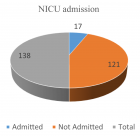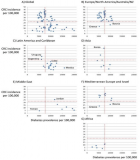Abstract
Thesis
Postdate Pregnancy Maternal and Fetal Outcomes among Sudanese Women
Awadalla Abdelwahid Suliman*, Gawahir Murad Abdelrahman, Hajar Suliman Ibrahim Ahmed, Abdelgadir Suliman Ibrahim, Kabbashi Mohammed Adam Hammad, Emad Abdalla Siddig Omer and Siddig Omer M Handady
Published: 10 October, 2023 | Volume 6 - Issue 4 | Pages: 165-171
Background: Postdated pregnancy is one of the most common obstetric problems associated with increased maternal morbidity, prenatal morbidity, and mortality. Pregnancy at 37-40 weeks of gestation is called the term from the last menstrual period. If the pregnancy exceeds 40 weeks, it is called a postdated pregnancy, but when pregnancy is prolonged beyond 42 weeks, it is called post-maturity or post-term pregnancy.
Objective: This study aimed to determine the adverse effects of postdate pregnancy on mothers and fetuses.
Methodology: This was a descriptive, prospective, cross-sectional, hospital-based study conducted at Omdurman Maternity Hospital from January 2018 to June 2018.
An interview questionnaire was used to collect data. Data were collected by trained doctors in the labor room. One hundred and thirty-eight (138) postdated pregnant women were included in this study after obtaining informed consent through a structured questionnaire. Demographic and clinical data concerning personal history, booking status, mode of delivery, maternal complications, and fetal complications were recorded.
Results: During the study period, 2751 women delivered, of which 138 were postdated deliveries, with a prevalence of 5%. Most women's age range was 31-34 years 48.6%). Their education level was mostly secondary school (42%). Primigravida 65%), booked were 75.4%. Previous history of postdate pregnancy was 34.1%, normal vaginal delivery was 79 .7%, cesarean section was 14.5%, and instrumental delivery 5.8%.
Cesarean section indications were cervical dystocia (14.4%), cephalopelvic disproportion (9.5%), meconium-stained liquor with fetal distress (33.3%), pathological cardiotocography (CTC) (19%), and failure to progress (23.8%).
Maternal complications included post-partum hemorrhage (PPH) (7.2%), perineal tears (.7%, cervical tears (1.4%), and postpartum infections (1.4%). Fetal complications were 14.5%, Shoulder Dystocia 2.9%, asphyxia (6.5%), and meconium aspiration (5.1%). The mean APGAR score was 1.1667, less than three in only 3.6%, and > 7 in 86.9%.
Neonatal death was 3%. Approximately 18 neonates were admitted to the Neonatal Intensive care unit (NICU) and only five of them were admitted for more than one week.
Conclusion: Postdate pregnancy prevalence in this study was 5%, which was associated with maternal risk of cesarean section delivery, instrumental delivery, postpartum hemorrhage, and postnatal infection.
Read Full Article HTML DOI: 10.29328/journal.cjog.1001146 Cite this Article Read Full Article PDF
Keywords:
Postdate; Pregnancy; Maternal; Fetal; Outcomes; Sudanese; Women
References
- Hauth JC, Goodman MT, Gilstrap LC 3rd, Gilstrap JE. Post-term pregnancy. I. Obstet Gynecol. 1980 Oct;56(4):467-70. PMID: 7422191.
- Savitz DA, Terry JW Jr, Dole N, Thorp JM Jr, Siega-Riz AM, Herring AH. Comparison of pregnancy dating by last menstrual period, ultrasound scanning, and their combination. Am J Obstet Gynecol. 2002 Dec;187(6):1660-6. doi: 10.1067/mob.2002.127601. PMID: 12501080.
- Wennerholm UB, Saltvedt S, Wessberg A, Alkmark M, Bergh C, Wendel SB, Fadl H, Jonsson M, Ladfors L, Sengpiel V, Wesström J, Wennergren G, Wikström AK, Elden H, Stephansson O, Hagberg H. Induction of labour at 41 weeks versus expectant management and induction of labour at 42 weeks (SWEdish Post-term Induction Study, SWEPIS): multicentre, open label, randomised, superiority trial. BMJ. 2019 Nov 20;367:l6131. doi: 10.1136/bmj.l6131. Erratum in: BMJ. 2021 Dec 15;375:n3072. PMID: 31748223; PMCID: PMC6939660.
- Carroll A, Lee S, Desforges M, Heazell A. A review of the evidence for placental aging in prolonged pregnancy. Medical Research Archives. 2020; 8(8). https://doi.org/10.18103/mra.v8i8.2188.
- Galal M, Symonds I, Murray H, Petraglia F, Smith R. Postterm pregnancy. Facts Views Vis Obgyn. 2012;4(3):175-87. PMID: 24753906; PMCID: PMC3991404.
- Dunn-Fletcher CE, Muglia LM, Pavlicev M, Wolf G, Sun MA, Hu YC, Huffman E, Tumukuntala S, Thiele K, Mukherjee A, Zoubovsky S, Zhang X, Swaggart KA, Lamm KYB, Jones H, Macfarlan TS, Muglia LJ. Anthropoid primate-specific retroviral element THE1B controls expression of CRH in placenta and alters gestation length. PLoS Biol. 2018 Sep 19;16(9):e2006337. doi: 10.1371/journal.pbio.2006337. PMID: 30231016; PMCID: PMC6166974.
- Linde A, Georgsson S, Pettersson K, Holmström S, Norberg E, Rådestad I. Fetal movement in late pregnancy - a content analysis of women's experiences of how their unborn baby moved less or differently. BMC Pregnancy Childbirth. 2016 Jun 1;16(1):127. doi: 10.1186/s12884-016-0922-z. PMID: 27245990; PMCID: PMC4888620.
- Warland J, O'Brien LM, Heazell AE, Mitchell EA; STARS Consortium. An international internet survey of the experiences of 1,714 mothers with a late stillbirth: the STARS cohort study. BMC Pregnancy Childbirth. 2015 Aug 15;15:172. doi: 10.1186/s12884-015-0602-4. PMID: 26276347; PMCID: PMC4537542.
- Heazell A. The role of maternal awareness of reduced fetal movements to reduce perinatal mortality remains unclear. BJOG. 2020 Jun;127(7):838. doi: 10.1111/1471-0528.16173. Epub 2020 Mar 9. PMID: 32061004.
- Sergent F, Lefèvre A, Verspyck E, Marpeau L. Diminution des mouvements actifs du foetus au troisième trimestre: que faire? [Decreased fetal movements in the third trimester: what to do?]. Gynecol Obstet Fertil. 2005 Nov;33(11):861-9. French. doi: 10.1016/j.gyobfe.2005.07.041. Epub 2005 Oct 21. PMID: 16243568.
- Chauveau L, Raia-Barjat T, Noblot E, Fanget C, Gallot D, Chaleur C. Évaluation des connaissances des femmes enceintes sur les mouvements actifs fœtaux lors de la visite de terme [Maternal knowledge of fetal movements in late pregnancy]. J Gynecol Obstet Biol Reprod (Paris). 2016 Apr;45(4):360-5. French. doi: 10.1016/j.jgyn.2015.06.006. Epub 2015 Jun 27. PMID: 26123016.
- Linde A, Rådestad I, Pettersson K, Hagelberg L, Georgsson S. "Better safe than sorry"-Reasons for consulting care due to decreased fetal movements. Women Birth. 2017 Oct;30(5):376-381. doi: 10.1016/j.wombi.2017.02.007. Epub 2017 Mar 27. PMID: 28359754.
- Moniod L, Hovine A, Trombert B, Rancon F, Zufferey P, Chauveau L, Chauleur C, Raia-Barjat T. Fetal Movement Counting in Prolonged Pregnancies: The COMPTAMAF Prospective Randomized Trial. Healthcare (Basel). 2022 Dec 18;10(12):2569. doi: 10.3390/healthcare10122569. PMID: 36554092; PMCID: PMC9778956.
- Usher RH, Boyd ME, McLean FH, Kramer MS. Assessment of fetal risk in postdate pregnancies. Am J Obstet Gynecol. 1988 Feb;158(2):259-64. doi: 10.1016/0002-9378(88)90134-2. PMID: 3341404.
- McLean FH, Boyd ME, Usher RH, Kramer MS. Postterm infants: too big or too small? Am J Obstet Gynecol. 1991 Feb;164(2):619-24. doi: 10.1016/s0002-9378(11)80035-9. PMID: 1992713.
- Arias F. Predictability of complications associated with prolongation of pregnancy. Obstet Gynecol. 1987 Jul;70(1):101-6. PMID: 3299174.
- Campbell MK, Ostbye T, Irgens LM. Post-term birth: risk factors and outcomes in a 10-year cohort of Norwegian births. Obstet Gynecol. 1997 Apr;89(4):543-8. doi: 10.1016/s0029-7844(97)00049-5. PMID: 9083310.
- Boyd ME, Usher RH, McLean FH, Kramer MS. Obstetric consequences of postmaturity. Am J Obstet Gynecol. 1988 Feb;158(2):334-8. doi: 10.1016/0002-9378(88)90150-0. PMID: 3277431.
- RCOG Evidence-Based Clinical Guidelines Induction of Labour, researchgate.net/publication/266045914_RCOG_Evidence-based_Clinical_Guidelines_Induction_of_labour.
- Who Recommendations on Induction of Labour, at or beyond Term. World Health Organization, World Health Organization, who.int/publications-detail-redirect/9789240052796.
- Onyebuchi A, Okafor L, Mamah J, Obi V, Esike C, Umeora O, Out C. International Journal of Women’s Health and Reproduction Sciences. 2023; 11: 33–36.
- Neetu S. Postdated pregnancy: Its maternal and fetal outcome. International Journal of Reproduction, Contraception, Obstetrics and Gynecology. 2020; 9: 3223. https://doi.org/10.18203/2320-1770.ijrcog20203299.
- Parul A. Maternal outcome of prolonged pregnancy. Journal of Bangladesh College of Physicians and Surgeons. 2015; 32:66-70, https://doi.org/10.3329/jbcps.v32i2.26033.
- Methal AA. Postdate Pregnancy: Maternal & Neonatal Outcome. The Medical Journal of Basrah University, University of Basrah, 30 June 2022. mjbu.uobasrah.edu.iq/article_176735.html.
- Tarimo CS, Mahande MJ, Obure J. Prevalence and risk factors for caesarean delivery following labor induction at a tertiary hospital in North Tanzania: a retrospective cohort study (2000-2015). BMC Pregnancy Childbirth. 2020 Mar 18;20(1):173. doi: 10.1186/s12884-020-02861-8. PMID: 32188409; PMCID: PMC7079438.
- Mahapatro A, Samal S. Feto maternal outcome in pregnancy beyond 40 weeks. Int J Pharma Bio Sci. 2015; 6(2):53-8.
- Kilby MD. To induce or not to induce? the management of a pregnancy near ‘post-term.’ Current Obstetrics & Gynaecology. 1994; 4(2): 85–89. https://doi.org/10.1016/0957-5847(94)90021-3
- Shivani S, Hemprobba G, Urvashi V, Gunjan Y. The study of maternal and perinatal outcomes in prolonged pregnancy. Int Report contracept Obstet Gyenecol. 2017; 6(3): 1067-1070.
- Pransukhbhai PY, Londhe P. Study of maternal and fetal outcome in postdate pregnancy in Tertiary Care Hospital. International Journal of Reproduction, Contraception, Obstetrics and Gynecology. 2020; 9(9):3585. https://doi.org/10.18203/2320-1770.ijrcog20203556.
- Smith ER, Oakley E, Grandner GW, Ferguson K, Farooq F, et al. Adverse maternal, fetal, and newborn outcomes among pregnant women with SARS-CoV-2 infection: an individual participant data meta-analysis. BMJ Glob Health. 2023 Jan;8(1):e009495. doi: 10.1136/bmjgh-2022-009495. PMID: 36646475; PMCID: PMC9895919.
- Caughey AB, Washington AE, Laros RK Jr. Neonatal complications of term pregnancy: rates by gestational age increase in a continuous, not threshold, fashion. Am J Obstet Gynecol. 2005 Jan;192(1):185-90. doi: 10.1016/j.ajog.2004.06.068. PMID: 15672023.
- Mahapatro A, Samal S. Feto maternal outcome in pregnancy beyond 40 weeks. Int J Pharma Bio Sci. 2015; 6(2):53-8.
- Nair PP, Jungari ML, Tiwari MR, Butola LK. Study of induction of labor with oral misoprostol and its maternal and perinatal outcome. International Journal of Current Research and Review. 2020; 77–81. https://doi.org/10.31782/ijcrr.2020.7781.
- Nofiasari T, Utami FS. Characteristics of Child Birthing Women and Fetal Outcome in Postdate Pregnancy. Advances in Social Science, Education, and Humanities Research. 2019; 436: 671-674.
- Agrawal M, Bhriegu R, Hariharan C. Assessment of maternal and perinatal outcome in postdated pregnancy. Journal of Datta Meghe Institute of Medical Sciences University. 2017; 12(1): 35. https://doi.org/10.4103/jdmimsu.jdmimsu_20_17 .
- Caughey AB, Washington AE, Laros RK Jr. Neonatal complications of term pregnancy: rates by gestational age increase in a continuous, not threshold, fashion. Am J Obstet Gynecol. 2005 Jan;192(1):185-90. doi: 10.1016/j.ajog.2004.06.068. PMID: 15672023.
- Mohammed AK. The relationship between some variables with birth outcome among postdate pregnant women delivering at Maternity Teaching Hospital Sulaymaniyah City, Iraq. Journal of Zankoy Sulaimani - Part A. 2020; 22(1): 389–398. https://doi.org/10.17656/jzs.10800.
- Kuller JA, Katz VL, McMahon MJ, Wells SR, Bashford RA. Pharmacologic treatment of psychiatric disease in pregnancy and lactation: fetal and neonatal effects. Obstet Gynecol. 1996 May;87(5 Pt 1):789-94. doi: 10.1016/0029-7844(95)00476-9. PMID: 8677088.
- Kuznetsova IV, Konovalov VA. Use of folic acid during pregravid preparation and pregnancy. Russian Bulletin of Obstetrician-Gynecologist. 2015; 15(1): 24. https://doi.org/10.17116/rosakush201515124-31.
- Indonesian Ministry of Health. 2016 National Health Indicator Survey Report. Indonesian Ministry of Health, Jakarta, 2017.
- Morken NH, Klungsøyr K, Skjaerven R. Perinatal mortality by gestational week and size at birth in singleton pregnancies at and beyond term: a nationwide population-based cohort study. BMC Pregnancy Childbirth. 2014 May 22;14:172. doi: 10.1186/1471-2393-14-172. PMID: 24885576; PMCID: PMC4037279.
Figures:

Figure 1

Figure 2

Figure 3

Figure 4

Figure 5
Similar Articles
-
TMD and pregnancy?Afa Bayramova*. TMD and pregnancy?. . 2018 doi: 10.29328/journal.cjog.1001001; 1: 001-006
-
Screening of Gestational diabetes mellitusGehan Farid*,Sarah Rabie Ali*,Reem Mohammed Kamal. Screening of Gestational diabetes mellitus . . 2018 doi: 10.29328/journal.cjog.1001003; 1: 014-023
-
The Case of the Phantom Trophoblastic TumorBenedict B Benigno*. The Case of the Phantom Trophoblastic Tumor. . 2018 doi: 10.29328/journal.cjog.1001004; 1: 024-025
-
Maternal and fetal outcome of comparative study between old & adopted new value of screening of Gestational Diabetes Mellitus in tertiary centre in Saudi ArabiaGehan Farid*,Reem Mohammed Kamal*,Mohamed AH Swaraldahab,Sarah Rabie Ali. Maternal and fetal outcome of comparative study between old & adopted new value of screening of Gestational Diabetes Mellitus in tertiary centre in Saudi Arabia. . 2018 doi: 10.29328/journal.cjog.1001005; 1: 026-034
-
Perinatal Morbidity & Mortality following repeat Cesarean section due to five or more previous Cesarean Section done in Tertiary centre in KSASomia Osman,Gehan Farid*,Reem Mohamed Kamal,Sarah Rabie Ali,Mohamed AH Swaraldahab. Perinatal Morbidity & Mortality following repeat Cesarean section due to five or more previous Cesarean Section done in Tertiary centre in KSA. . 2018 doi: 10.29328/journal.cjog.1001007; 1: 045-051
-
Septic arthritis of left shoulder in pregnancy following minor hand injuryNeelam Agrawal,Rhoughton Clemmey,Shamma Al-Inizi*. Septic arthritis of left shoulder in pregnancy following minor hand injury. . 2018 doi: 10.29328/journal.cjog.1001010; 1: 058-060
-
Current anesthesıa for Cesarean SectıonDemet Dogan Erol*, Ismail Aytac. Current anesthesıa for Cesarean Sectıon. . 2018 doi: 10.29328/journal.cjog.1001011; 1: 061-066
-
Value of ambulatory blood pressure measure in pregnancy hypertensionAna Correia*,Fátima Leitão. Value of ambulatory blood pressure measure in pregnancy hypertension. . 2018 doi: 10.29328/journal.cjog.1001012; 1: 067-072
-
Immediate postplacental insertion of intrauterine contraceptive device (copper 375) and its complications in term of expulsion, infection and perforationBenish Khanzada*,Mala Jitendra Shahani,Areesha Kamran Khanzada. Immediate postplacental insertion of intrauterine contraceptive device (copper 375) and its complications in term of expulsion, infection and perforation . . 2018 doi: 10.29328/journal.cjog.1001014; 1: 082-086
-
Managing epileptic women in pregnancySarmad Muhammad Soomar*,Saima Rajpali. Managing epileptic women in pregnancy. . 2019 doi: 10.29328/journal.cjog.1001015; 2: 001-002
Recently Viewed
-
Fiesta vs. Stress Condition the Incidence and the Age at Menarche. Forty Years of ResearchCarlos Y Valenzuela*. Fiesta vs. Stress Condition the Incidence and the Age at Menarche. Forty Years of Research. Clin J Obstet Gynecol. 2025: doi: 10.29328/journal.cjog.1001190; 8: 069-073
-
The Bacteriological Profile of Nosocomial Infections at the Army Central Hospital of BrazzavilleMedard Amona*,Yolande Voumbo Matoumona Mavoungou,Hama Nemet Ondzotto,Benjamin Kokolo,Armel Itoua,Gilius Axel Aloumba,Pascal Ibata. The Bacteriological Profile of Nosocomial Infections at the Army Central Hospital of Brazzaville. Int J Clin Microbiol Biochem Technol. 2025: doi: 10.29328/journal.ijcmbt.1001032; 8: 009-022
-
Parents’ perception of the school nurse’s roleDiane Gillooly*,Ganga Mahat,Patricia Paradiso. Parents’ perception of the school nurse’s role. J Adv Pediatr Child Health. 2020: doi: 10.29328/journal.japch.1001021; 3: 064-067
-
A girl with a stiff neckG Carlone*,A Prisco,F Vittoria,E Barbi,M Carbone. A girl with a stiff neck. J Adv Pediatr Child Health. 2020: doi: 10.29328/journal.japch.1001019; 3: 058-060
-
A rare case of acute necrotising pancreatitis in a paediatric patientLizeri Jansen*,Gabrielle Colleran,Ikechukwu Okafor,Nuala Quinn. A rare case of acute necrotising pancreatitis in a paediatric patient. J Adv Pediatr Child Health. 2020: doi: 10.29328/journal.japch.1001020; 3: 061-063
Most Viewed
-
Feasibility study of magnetic sensing for detecting single-neuron action potentialsDenis Tonini,Kai Wu,Renata Saha,Jian-Ping Wang*. Feasibility study of magnetic sensing for detecting single-neuron action potentials. Ann Biomed Sci Eng. 2022 doi: 10.29328/journal.abse.1001018; 6: 019-029
-
Evaluation of In vitro and Ex vivo Models for Studying the Effectiveness of Vaginal Drug Systems in Controlling Microbe Infections: A Systematic ReviewMohammad Hossein Karami*, Majid Abdouss*, Mandana Karami. Evaluation of In vitro and Ex vivo Models for Studying the Effectiveness of Vaginal Drug Systems in Controlling Microbe Infections: A Systematic Review. Clin J Obstet Gynecol. 2023 doi: 10.29328/journal.cjog.1001151; 6: 201-215
-
Causal Link between Human Blood Metabolites and Asthma: An Investigation Using Mendelian RandomizationYong-Qing Zhu, Xiao-Yan Meng, Jing-Hua Yang*. Causal Link between Human Blood Metabolites and Asthma: An Investigation Using Mendelian Randomization. Arch Asthma Allergy Immunol. 2023 doi: 10.29328/journal.aaai.1001032; 7: 012-022
-
Impact of Latex Sensitization on Asthma and Rhinitis Progression: A Study at Abidjan-Cocody University Hospital - Côte d’Ivoire (Progression of Asthma and Rhinitis related to Latex Sensitization)Dasse Sery Romuald*, KL Siransy, N Koffi, RO Yeboah, EK Nguessan, HA Adou, VP Goran-Kouacou, AU Assi, JY Seri, S Moussa, D Oura, CL Memel, H Koya, E Atoukoula. Impact of Latex Sensitization on Asthma and Rhinitis Progression: A Study at Abidjan-Cocody University Hospital - Côte d’Ivoire (Progression of Asthma and Rhinitis related to Latex Sensitization). Arch Asthma Allergy Immunol. 2024 doi: 10.29328/journal.aaai.1001035; 8: 007-012
-
An algorithm to safely manage oral food challenge in an office-based setting for children with multiple food allergiesNathalie Cottel,Aïcha Dieme,Véronique Orcel,Yannick Chantran,Mélisande Bourgoin-Heck,Jocelyne Just. An algorithm to safely manage oral food challenge in an office-based setting for children with multiple food allergies. Arch Asthma Allergy Immunol. 2021 doi: 10.29328/journal.aaai.1001027; 5: 030-037

If you are already a member of our network and need to keep track of any developments regarding a question you have already submitted, click "take me to my Query."















































































































































